2022.07.04.40
Files > Volume 7 > Vol 7 No 4 2022
The effect of adding compound fertilizer of NPK and Humic acid on the availability of NPK soil and cabbage yield
Miaad Ibrahim Turki 1,Basem Rahem Bader2*
1 Department of Soil Science and Water Resources, College of Agriculture, University of Diyala, Iraq.
2 Department of Soil Science and Water Resources, College of Agriculture, University of Diyala, Iraq.
* Correspondence: [email protected]
Available from: http://dx.doi.org/10.21931/RB/2022.07.04.40
ABSTRACT
A field experiment was conducted in Jdeidet Al-Shatt in Diyala Governorate during the fall season of 2021. According to modern American classification, silt loam soil is classified at a level lower than Typic Torrifluvent. To study the effect of NPK and humic acid addition on soil NPK availability and total cabbage yield according to RCBD randomized complete block design with three replications. The balanced 20:20:20 NPK compound fertilizer was added at three levels, 0,150,300 kg ha-1 and humic acid at three levels, 0, 15 and 30 kg ha-1. The fertilizers were added to the soil in two batches, the first during the planting process and the second 43 days after the date of the first batch. The concentrations of elements were measured in two stages, and the total yield of cabbage. The results of the study showed the superiority of the compound fertilizer NPK at the level of 300 kg ha-1 of NPK elements and in the first stage 46days (before the emergence of the head), where the concentration of NPK elements reached 36.59 mg kg-1, 35.55 mg kg-1, 224.90 mg kg-1, respectively. While the superiority of the humic acid at the level of 30 kg ha-1 to 30.44 mg kg-1, 25.13 mg kg-1, and 209.39 mg kg-1, respectively. As for the compound fertilizer at the second stage106 days (when the head is fully mature), the concentration of NPK elements and cabbage yield reached 27.17 mg kg-1, 36.92 mg kg-1, 208.69 mg kg-1, 68.23kg Mg ha-1, while the humic acid was 22.86 mg kg-1, 27.91 mg kg-1, 197.11 mg kg-1, 57.53 Mg ha-1, respectively.
Keywords: NPK compound fertilizer, Humic acid, NPK readiness, cabbage
INTRODUCTION
Most Iraqi soils are considered calcareous because of their high content of carbonate minerals such as calcium carbonate. These minerals reduce soil fertility by raising pH, exposing the nutrients added to the soil to sedimentation, loss and stabilization processes, and high temperatures and low rainfall, one of the challenges facing soils in dry and semi-arid areas, including Iraqi soils. This causes a decrease in the soil's organic material content 1, 2. Adding fertilizers to the ground dramatically increases the availability of crop nutrients and improves the soil ecosystem that contributes mainly or is secondary to 95 percent of global food production. Proper fertilizers can increase agricultural productivity by avoiding deforestation and reducing the need to use additional lands for agriculture. Chemical fertilizers are an indispensable resource for increasing agricultural production, which leads to increasing yields by up to 50 percent and improving farmers' livelihoods 3,4. Nitrogen is the essential component of all living organisms and one of the primary nutrients that limit life on our planet. Nitrogen is exposed to various loss processes, including fixation in the bodies of microorganisms or volatilization. Phosphorus is an essential nutrient for crop growth; it is a non-renewable resource in global food security; Phosphorus is poorly soluble in soil and has weak plant uptake efficiency, Phosphorus availability in soil is affected by temperature, dryness and pH, and maximum phosphorus uptake from the soil is at pH 7-6.5. This will affects the availability of Phosphorus in the soil, especially in calcareous soils 5. Potassium is the third phytonutrient that is not available to plants. Intensive cultivation, runoff and soil erosion cause a deficiency of Potassium in the soil 6. Humic acid (HA) is a multifunctional natural polymer compound in most terrestrial and aquatic environments. Humic acid effectively influences the absorption of elements from the soil, as it helps to increase the readiness and transfer of significant components, including Nitrogen, phosphorous and potassium 7, 8. Humic acid is a sustainable and environmentally friendly fertilizer ready directly when added to the soil. It does not need time to decompose, free of seeds, weeds, bushes and pathogens compared to traditional organic fertilizer. Since Humic acid can dissolve in the bases, adding it to the calcareous soil, including most the Iraqi soil, leads to a lowering of the soil pH and thus drives an increase in the readiness of the elements in the ground and its absorption by the plant, Humic acid is a supplement to chemical fertilizers. It helps in reduce agricultural production input costs. To increase the amount of farm production and to meet the world's food requirements, resulting from the increased use of chemical fertilizers increased, but the high prices and fear of losing them because they cause pollution. Therefore, it was necessary to find alternative ways to reduce its loss from the soil. The use of humic acid with chemical fertilizer, according to the fertilizer's recommendation, increases the soil's elements when added as a mixture or feed in the ground. This makes it ready for absorption by the plant for a long time, which reduces the loss of added elements from the soil 9,10. Because of the importance of cabbage cultivation in Iraq, as it is one of the main winter crops Based on the preceding, the study aimed to find out the effect of adding NPK and Humic acid fertilizers and the interaction between them on the availability of NPK soil and total yield of cabbage.
MATERIALS AND METHODS
A field experiment was conducted in one of the fields of Jdeidet Al-Shatt territory of Al-Khalis district in Diyala governorate, located 30 km from the center of Baquba in Diyala Governorate and located at longitude 44°25'33.2868'E and at latitude 33°37'29.172'N during the autumn season 2021 on silty loam soil. The study aimed to examine the effect of adding NPK compound fertilizer and humic acid on soil availability. Total cabbage yield was evaluated by adding a balanced 20:20:20 NPK compound fertilizer at three different levels. These were: 0 no addition, 150 kg h-1 half of the fertilizer recommendation, 300 kg h-1 full of the fertilizer recommendation 11 whose symbol is C1, C2, C3, respectively. The second factor is humic acid with three levels, which are 0 no addition, 0, 15 kg ha-1, and 30 kg ha-1; its symbol is H1, H2, and H3, respectively. A sample was taken randomly from different locations and mixed to be a composite sample representative of the field soil at a depth of 0-30 cm. It was dried and ground with a wooden hammer and passed through a sieve with a hole diameter of 2 mm to perform the physical and chemical analyzes, whose results are shown in Table No 1.
Soil preparations were carried out for cultivation, including plowing, smoothing and leveling, and it was divided into three sectors. Each sector contains nine parameters, the dimensions of the experimental unit are 3 * 2.5 m2, and each experimental unit includes four lines. The number of plants in the experimental unit is 24 plants. The planting was done on terraces. The width of the terrace was 50 cm, seedlings were planted on one side, and the distance between one plant and another was 40 cm. The distance between an experimental unit and another 100 cm, and the distance between one sector and another 100 cm. The seedlings were planted in the field on 9/24/2021. The ground addition of NPK fertilizer and humic acid was applied in two stages, the first when planting and the second on 6/11/2021 before the stage of the emergence of the head after 43 days, by making an incision in the soil around the plant. Measurements were taken from the ground in two stages, the first stage before the emergence of the head and the second on the 7/1/2022 stage after the maturity of the head. The analyzes were carried out in the Laboratory of Soil and Water Resources Sciences, College of Agriculture, Diyala University, and the following characteristics were studied:
Nitrogen availability concentrations in soil mg kg -1
Estimation was performed by extracting the soil with potassium chloride (2N), adding magnesium oxide and converting Nitrogen from nitrate to ammonium by adding Devarde alloy as a reducing agent. Estimation was carried out using the Microelectronic apparatus 12.
Phosphorous availability concentration in soil mg kg -1
It is estimated using sodium bicarbonate (0.5M) at pH 8.5. Where Ammonium Molybdate and ascorbic acid are added until the blue color develops. A spectrophotometer is used at wavelength 882 13,14.
Potassium availability concentration in soil mg kg -1
The determination of ammonium acetate was carried out by using a flame photometer 14.
The total yield of the plant Mg ha-1
The total plant yield was calculated using the following equation:
The total plant yield was computed using the next equation:= Weight of the head without the outer leaves x the number of plants per hectare / 1000.
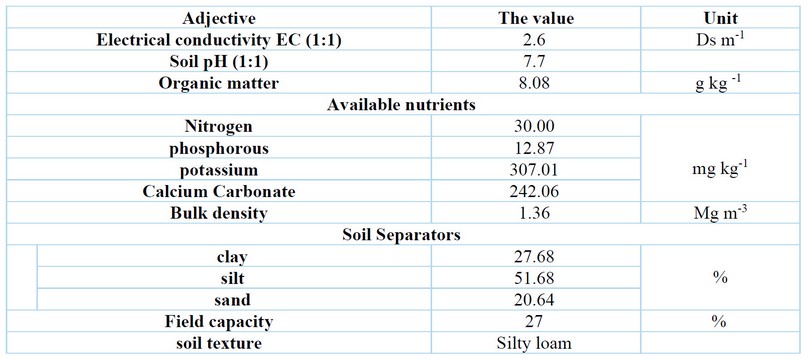
Table 1. Soil characteristics study before planting
RESULTS AND DISCUSSION
Nitrogen availability in the soil (mg kg-1)
Table 2 shows that the addition of NPK compound fertilizer and humic acid in the average concentrations of nitrogen availability in the soil, There are significant differences as the C2 and C3 two transactions were significantly superior, which two reached the highest average of 22.61,36.59mg kg-1 on respectively compared to C1 treatment, which amounted to 16.65 mg kg-1, with an increase of 35.79% and 119.75%. As for the effect of adding humic acid, the H2 and H3 two transactions were significantly superior, which two reached the highest average of 24.31, and 30.44 mg kg-1, respectively, were very special to the H1 treatment, which amounted to 21.10 mg kg-1, with an increase of 15.21% and 44.26%, respectively. As for the interaction effect, the C3H3 treatment, which amounted to 48.83 mg kg-1, showed the highest and lowest values for the C1H1 treatment, which amounted to 14.13 mg kg-1, and an increase of 245.57% percent.
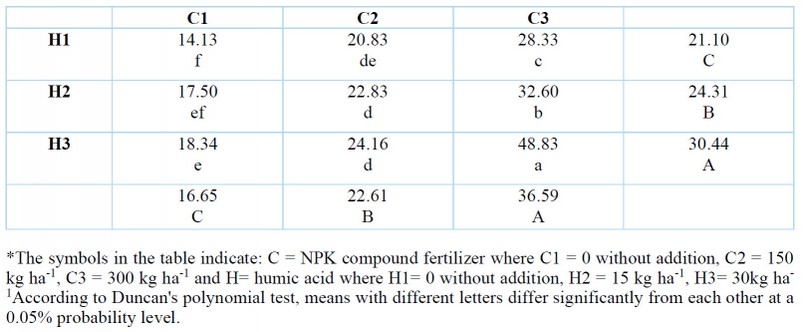
Table 2. Effect of adding NPK and Humic acid fertilizers and the interaction between them on nitrogen concentrations in soil in the pre-emergence of the head stage (mg kg-1)
Phosphorous availability in the soil (mg kg-1)
Table 3 shows that the addition of NPK compound fertilizer and humic acid had a significant effect on the average concentrations of phosphorous availability in the soil, as the C2 and C3 two transactions were significantly superior, which two reached the highest average of 15.79, 35.55mg kg-1, respectively compared to treatment C1 which amounted to 11.95 mg kg-1, with an increased rate 32.13% and 197.48%. As for the effect of adding humic acid, the average H3 treatment, which amounted to 25.13 mg kg-1, was significantly superior to the H1 treatment, which amounted to 17.05 mg kg-1, with an increase of 47.39%. As for the effect of the interaction, the C3H3 treatment, which amounted to 42.08 mg kg-1, showed the highest value and the lowest value, when C1H1 treatment, which amounted to 11.79 mg kg-1, and an increase of 256.91%.
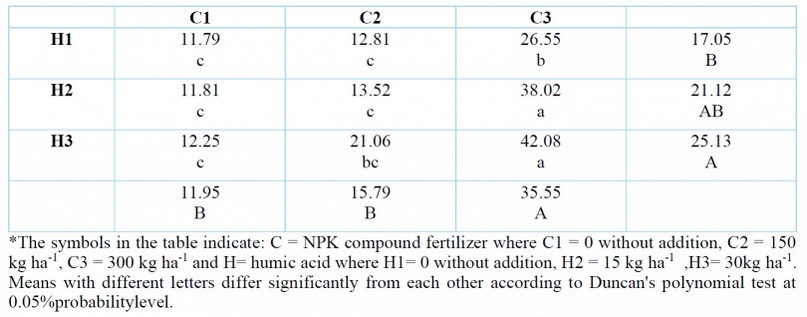
Table 3. Effect of adding NPK compound fertilizer and humic acid and their interaction on phosphorous concentrations in the soil in the pre-emergence of the head stage (mg kg-1).
Potassium availability in the soil (mg kg-1)
Table 4 shows that the addition of NPK compound fertilizer and humic acid had a significant effect on the average concentrations of potassium availability in the soil, as the C2 and C3 two transactions were significantly superior, which two reached the highest average of 198.01, 224.90 mg kg-1, respectively compared to treatment C1 which amounted to181.69 mg kg-1, with an increased rate 8.98% and 23.78%. As for the effect of adding humic acid, the average H3 treatment, which amounted to 209.39 mg kg-1, was significantly superior to the H1 treatment, which amounted to 194.83 mg kg-1, with an increase of 7.47%. As for the effect of the interaction, the C3H3 treatment, which amounted to 232.70 mg kg-1, showed the highest value and the lowest value when the C1H1 treatment amounted to 174.00 mg kg-1 and an increase of 33.73%.
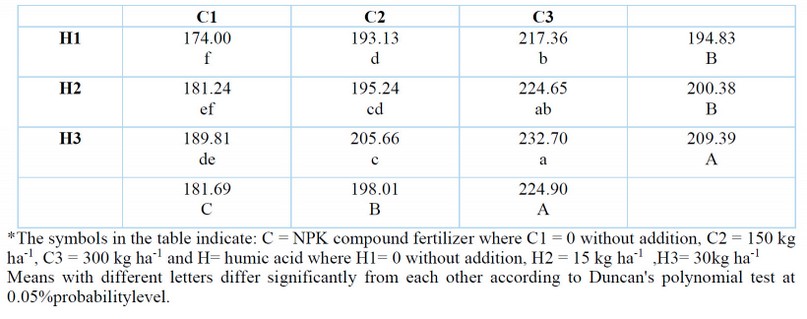
Table 4. Effect of adding NPK and humic acid fertilizer and the interaction between them on potassium concentrations in the soil in the pre-emergence of the head stage (mg kg-1)
Nitrogen availability in the soil (mg kg-1)
Table 5 shows that the addition of NPK compound fertilizer and humic acid had a great effect on the average concentrations of Nitrogen availability in the soil, as the C2 and C3 two transactions were significantly superior, which two reached the highest average of 20.79,27.17 mg kg-1 compared to C1 treatment, which amounted to 14.16 mg kg-1, respectively with an increase of 46.82 and 91.87 %, As for the effect of adding humic acid, as the H2and H3 treatment two transactions were significantly superior which two reached the highest average of 20.69,22.86 mg kg-1, was significantly superior to H2 and H1 treatment, which amounted to 18.58mg kg-1, respectively with an increase of 11.35and 23.03%, As for the interaction effect, C3H3 treatment which amounted to 30.00mg kg-1 showed the highest value and the lowest value when C1H1 treatment which amounted to 11.63mg kg-1, and an increased rate of 157.95%.
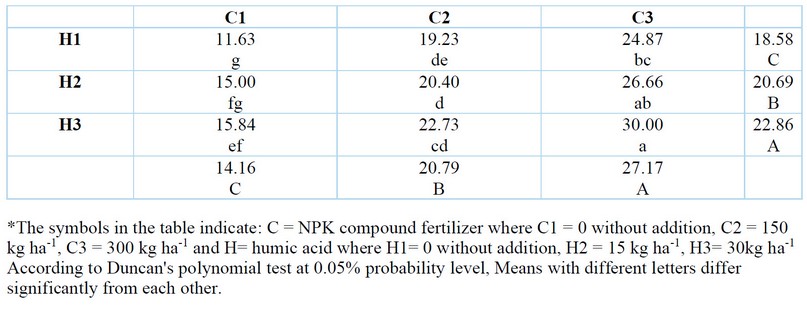
Table 5. Effect of adding NPK and humic acid fertilizer and the interaction between them on nitrogen concentrations in the soil at the stage of full maturity of the head (mg kg-1)
Phosphorous availability in the soil (mg kg-1)
Table 6 shows that the addition of NPK compound fertilizer and humic acid had a significant effect on the average concentrations of Phosphorous availability in the soil, as the C2 and C3 two transactions were significantly superior, which two reached the highest average of 21.58,36.92 mg kg-1 compared to C1 treatment which reached 12.49 mg kg-1, respectively with an increased rate of 72.77% and 195.59%, As for the effect of adding humic acid, as the H2 and H3 two transactions were significantly superior which two reached the highest average of 23.69,27.91 mg kg-1 was significantly superior to H1 treatment which amounted to 19.40mg kg-1, respectively with an increase of 22.11 % and 43.86%, As for the interaction effect, C3H3 treatment, which amounted to 45.49 mg kg-1 showed the highest value and the lowest value when C1H1 treatment, which amounted to 11.50 mg kg-1, and an increase of 295.56%.
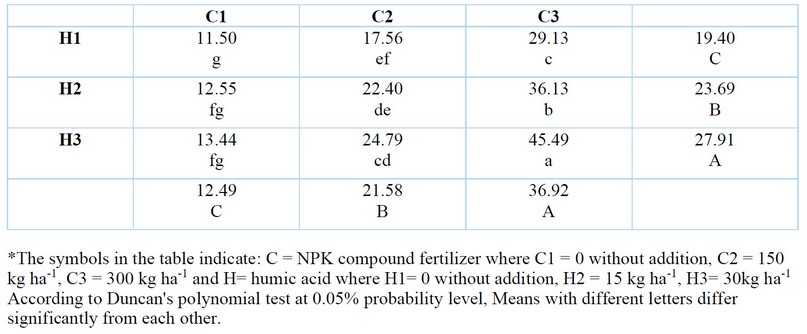
Table 6. Effect of adding NPK compound fertilizer and humic acid and the interaction between them on phosphorous concentrations in the soil at the stage of full maturity of the head (mg kg-1)
Potassium availability in the soil (mg kg-1)
Table 7 shows that the addition of NPK compound fertilizer and humic acid had a significant effect on the average Potassium availability in the soil, as the C2 and C3 two transactions were s significantly superior, which two reached the highest average of 189.81, and 208.69 mg kg-1 compared C1 treatment, which amounted to 169.90 mg kg-1, respectively, with an increase of 11.71and 22.83%, As for the effect of adding humic acid,as the H2 and H3 two transactions were s significantly superior which two reached the highest average of189.48,197.11mg kg-1 was significantly superior to H1 treatment which amounted to 181.81 mg kg-1, respectively, with an increase of 4.21% and 8.41%, As for the interaction effect, the C3H3 treatment which amounted to 220.26 mg kg-1, showed the highest value and the lowest value for C1H1 treatment which amounted to 162.74 mg kg-1, and an increase of 35.34%.
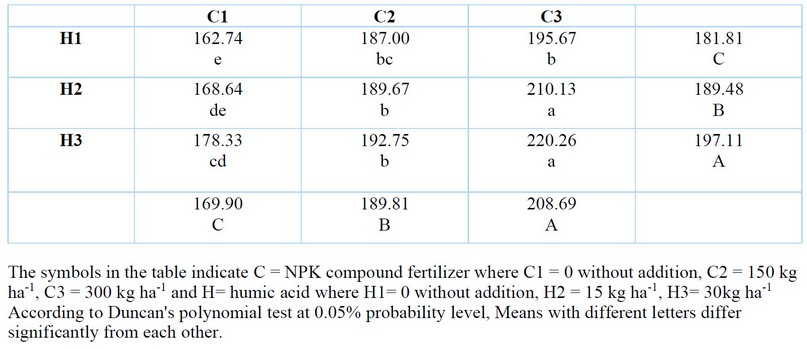
Table 7. Effect of adding NPK and humic acid fertilizer and the interaction between them on potassium concentrations in the soil in the stage of full maturity of the head (mg kg-1)
The total yield of the plant Mg ha-1.
Table 8 shows that the addition of the NPK compound fertilizer and humic acid had a significant effect on the average total yield of the plant, as the C2 and C3 two transactions were significantly superior, which two reached the highest average of 57.88, 68.23 Mg ha-1 compared to the treatment C1 which amounted to 33.77 Mg ha-1, respectively with an increased rate 71.39 and 102.04%, As for the effect of adding humic acid, as the H2and H3, two transactions were significantly superior, which two reached the high est average of 54.29,57.53 Mg ha-1, showed a significant superiority over H1 treatment, which amounted to 48.06 Mg ha-1, respectively, with an increase of 12.96 and 19.70%, As for the effect of the interaction, the C3H3 treatment which amounted to 70.61Mg ha-1 showed a value and the lowest value for C1H1 treatment which amounted to 26.11 Mg ha-1, and an increase of 170.43%.
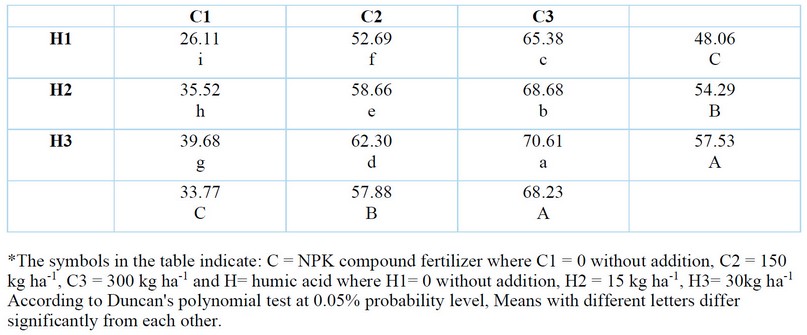
Table 8. Effect of adding NPK and humic acid fertilizer and the interaction between them on the concentrations of the total yield of the plant(Mg ha-1)
DISCUSSION
The results in tables 2,3,4,5 and 6,7,8 show that the compound fertilizer NPK and humic acid had a role in all the characteristics mentioned in the above tables, as the use of compound fertilizer NPK at the level of 300 kg ha-1. This led to an increase in the availability of Nitrogen, phosphorous and Potassium ready in the soil. This may be attributed to adding the compound fertilizer, which leads to the rapid release of the elements and an increase in their readiness 15, 16,17,18,19, 20,21.
The results of Tables 2, 3, 4,5,6,7,8 the superiority of humic acid significantly in the above-studied traits. Humic acid may be a source of nutrients. It may also be attributed to the role of humic acid in holding water in the soil, which helps to maintain soil moisture and thus encourages the increase of root branches and thus helps in the absorption of nutrients it may be attributed to the role of humic acid, which helps to release the nutrients associated with minerals and salts available in the soil, Humic acid works to reduce the degree of soil reaction, which leads to reducing the processes of loss and sedimentation. As it attracts nutrients and helps dissolve them slowly and continuously, this positively reflects on increasing soil productivity and plant yield 7, 22, 23,24,25.
The combined application of the compound fertilizer NPK and humic acid led to a more significant increase in the availability of the elements compared to their effect. 26,27, 28,29 And its combination with organic fertilizers leads to a rise in soil productivity beyond what can be achieved with a single use.
CONCLUSION
Adding NPK compound fertilizer 300 kg ha-1 led to an increase in the efficiency of the elements in the soil, its ability to supply the plant with what it needs, and an increase in the residual effect.
The addition of humic acid 30 kg ha-1 led to an increase in the concentrations of Nitrogen, Phosphorous, and Potassium and the total yield of the plant, thus meeting the plant's needs for these nutrients.
Conflict of interest
The authors declare that they have no known competing financial interests or personal relationships that could have appeared to influence the work reported in this manuscript
REFERENCES
1. Al-Nuaimi, S. N. A. Fertilizers and Soil Fertility. Second Edition. University of Al Mosul. Iraq. 1999.
2. Bityutskii, N. P., Yakkonen, K. L., Petrova, A. I., Lukina, K. A., & Shavarda, A. L. Calcium carbonate reduces the effectiveness of soil-added monosilicic acid in cucumber plants. Journal of Soil Science and Plant Nutrition, 2019. 19(3), 660-670. https://doi.org/10.1007/s42729-019-00066-3
3. FAO.The International Code of Conduct for the Sustainable Use and Management of Fertilizers. 2019.
4. Chuan, L., Zheng, H., Sun, S., Wang, A., Liu, J., Zhao, T., & Zhao, J. A sustainable way of fertilizer recommendation based on yield response and agronomic efficiency for chinese cabbage. Sustainability, 2019. 11(16), 4368. https://doi.org/10.3390/su11164368
5. Penn, C. J., & Camberato, J. J. A critical review on soil chemical processes that control how soil pH affects phosphorus availability to plants. Agriculture, . 2019.9(6), 120. https://doi.org/10.3390/agriculture9060120.
6. Das, I., & Pradhan, M. Potassium-solubilizing microorganisms and their role in enhancing soil fertility and health. In Potassium solubilizing microorganisms for sustainable agriculture 2016. (pp. 281-291). Springer, New Delhi. https://doi.org/10.1007/978-81-322-2776-2_20
7. Taj Al-Din, M. M,&. Al-Barakat, H.N. K. Effect of bio-fertilizer, foliar spray and ground addition of humic and fulvic acids on the readiness of N, p and K in the soil. Al-Muthanna Journal of Agricultural Sciences 2016. 61-56: (2)4.
8. Yang, F., & Antonietti, M. The sleeping giant: A polymer view on humic matter in synthesis and applications. Progress in Polymer Science, 2020. 100, 101182. https://doi.org/10.1016/j.progpolymsci.2019.101182
9. Khattak, R. A., & Dost, M. Seed cotton yield and nutrient concentrations as influenced by lignitic coal derived humic acid in salt-affected soils. Sarhad Journal of Agriculture, 2010. 26(1), 43-49.
10. Li, Y. Research progress of humic acid fertilizer on the soil. In Journal of Physics: Conference Series. 2020 (Vol. 1549, No. 2, p. 022004). IOP Publishing.
11. Al-Zuhairy, H. T. H., & AL-Hamdany, S. A. EFFECT OF ORGANIC, CHEMICAL FERTILIZERS AND PLANT DENSITY ON: 2-SOME GROWTH AND YIELD CHARCTERISTICS OF CAULIFLOWER Brassica oleracea var. botrytis. Diyala Agricultural Sciences Journal, 2017. 9(2), 104-114.
12. Black, C. A. Methods of soil analysis: Part 2. Chemical and microbiological properties. Am.Soc .Agronomy .Inc.Publisher,Wisconsin,USA. 1965b.
13. Olsen, S. R., & Sommers, L. E. Phosphorus. p. 1982. 403–430. AL Page et al.(ed.) Methods of soil analysis. Part 2. Agron. Monogr. 9. ASA and SSSA, Madison
14. Page, A.L., Miller, R.H. and Keeney, D.R. Methods of Soil Analysis. Part 2. Chemical and Microbiological Properties. American Society of Agronomy. In Soil Science Society of America, 1982 Vol. 1159.
15. AL-Mughrabi, N. M. H. Effect of adding phosphate and potassium fertilizers and their interactions on some soil chemical properties. Alexandria Journal for Scientific Exchange.36(January-March), 2015. 77-87. doi: 10.21608/asejaiqjsae.2015.158324.
16. Taban, S. K. EFFECT OF ORGANIC FERTILIZER, PHOSPHORUS SOURCES AND AMOUNTS OF IRRIGATION WATER IN P AVAILABLE IN SOIL. Diyala Agricultural Sciences Journal, 2016. 8(2), 162-171.
17. Majeed, D. A., & Odhafa, A. K. H. Evaluation the Availability of Potassium Forms with the Effect of Adding Organic, Potassium Fertilizers and Deficit Irrigation in Agricultural Conditions. iraqi journal of soil science, 2019. 19(1).
18. Ahmed, W. A. Effect of organic matter and sulfur in the availabilityof Phosphorus in different soil texture in Basrah Governorate. Misan Journal of Academic Studies, 2019. 18(35-1).
19. Al-Mharib, M. Z. K., Al-Saadi, F. M. J., & Almashhadany, A. H. Studies on growth and yield indicators for kohlrabi (Brassica oleracea) plant treated with mineral fertilizers and root enhancers. Research on Crops, 2020. 21(2), 333-338.
20. Ofori, P., Asamoah, G., Amoah, B., Agyeman, K. O. A., & Yeboah, E. Combined application of poultry litter biochar and NPK fertilizer improves cabbage yield and soil chemical properties. Open Agriculture, 2021. 6(1), 356-368.
21. Šimanský, V., Jonczak, J., Horváthová, J., Igaz, D., Aydın, E., & Kováčik, P. Does long-term application of mineral fertilizers improve physical properties and nutrient regime of sandy soils?. Soil and Tillage Research,2022. 215, 105224. https://doi.org/10.1016/j.still.2021.105224.
22. Li, Y., Fang, F., Wei, J., Wu, X., Cui, R., Li, G., & Tan, D. Humic acid fertilizer improved soil properties and soil microbial diversity of continuous cropping peanut: a three-year experiment. Scientific reports, 2019. 9(1), 1-9. https://doi.org/10.1038/s41598-019-48620-4
23. Belal, E. E., El Sowfy, D. M., & Rady, M. M. Integrative soil application of humic acid and sulfur improves saline calcareous soil properties and barley plant performance. Communications in Soil Science and Plant Analysis, 2019. 50(15), 1919-1930. https://doi.org/10.1080/00103624.2019.1648497.
24. Olk, D. C., Bloom, P. R., De Nobili, M., Chen, Y., McKnight, D. M., Wells, M. J. M., & Weber, J. 2019. Using humic fractions to understand natural organic matter processes in soil and water: Selected studies and applications. Journal of environmental quality, 2019. 48(6), 1633-1643. https://doi.org/10.2134/jeq2019.03.0100.
25. Chen, Q., Qu, Z., Ma, G., Wang, W., Dai, J., Zhang, M., & Liu, Z. Humic acid modulates growth, photosynthesis, hormone and osmolytes system of maize under drought conditions. Agricultural Water Management, 2022. 263,107447. https://doi.org/10.1016/j.agwat.2021.107447.
26. Korsaeth, A. N, P, and K budgets and changes in selected topsoil nutrients over 10years in a long-term experiment with conventional and organic crop rotations. Appl.Environ. Soil Sci. J. 2012 25, 1–17. https://doi.org/10.1155/2012/539582
27. Singh, G., Singh, S. H. E. R., & Singh, S. S. Integrated nutrient management in rice and wheat crop in rice-wheat cropping system in lowlands. Annals of Plant and Soil Research, 2013. 15(1), 1-4.
28. Verma, R., Maurya, B. R., & Meena, V. S. Integrated effect of bio-organics with chemical fertilizer on growth, yield and quality of cabbage (Brassica oleracea var capitata). Indian J Agric Sci, 2014 84(8), 914-919.
29. Dhaliwal, S. S., Naresh, R. K., Mandal, A., Walia, M. K., Gupta, R. K., Singh, R., & Dhaliwal, M. K. Effect of manures and fertilizers on soil physical properties, build-up of macro and micronutrients and uptake in soil under different cropping systems: a review. Journal of Plant Nutrition, 2019. 42(20) 2873-2900. https://doi.org/10.1080/01904167.2019.1659337.
Received: August 25, 2022 / Accepted: October 12, 2022 / Published:15 November 2022
Citation: Turki M I, Bader B R. The effect of adding compound fertilizer of NPK and Humic acid on the availability of NPK soil and cabbage yield. Revis Bionat a 2022;7(4) 40. http://dx.doi.org/10.21931/RB/2022.07.04.40
